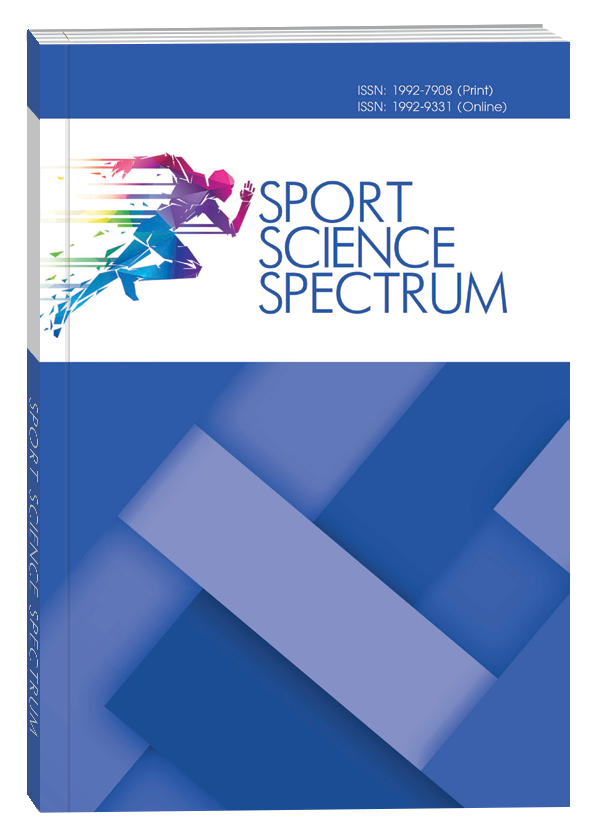FORMATION OF TEENAGERS’ VALUE ORIENTATUONS DURING PHYSICAL EDUCATION
DOI:
https://doi.org/10.32782/spectrum/2024-1-10Keywords:
health, value, schoolchildren, lesson, classAbstract
The article examines the value orientations of teenagers. It is the system of value orientations that determines the meaningful side of an individual’s orientation, attitude to the environment and to himself, which ultimately constitutes his life concept and lifestyle. The study and analysis of value orientations will increase the level of motivation for physical education classes and contribute to improving the health of the younger generation. The goal is to determine the value orientation of teenagers during physical education. Research methods: the following research methods were used to achieve the goal: analysis of scientific and methodological literature, questionnaire of value orientations by M. Rokych, and methods of mathematical statistics. The results. The most important terminal values for boys are: health (physical and mental) – 31.37 points; good and reliable friends – 31.13 points; satisfaction (life full of pleasures, pleasant pastime, lots of entertainment) – 30.68 points; love (spiritual and physical intimacy with a loved one) – 30.48 points, and self-confidence (freedom from internal contradictions and doubts) – 30.28 points. A similar trend is observed in girls. They attributed the following to the core of values: good and reliable friends – 31.03 points; health (physical and mental) – 30.84 points; satisfaction (life full of pleasures, pleasant pastime, lots of entertainment) – 30.78 points; love (spiritual and physical intimacy with a loved one) – 30.6 points and, unlike boys, interesting work – 30.47 points. The general rating of priority instrumental values for boys and girls is almost the same. The difference is only in the first two positions: boys – honesty (truthfulness, sincerity) – 30.34 points; education (good manners, politeness) – 30.24 points; girls – cheerfulness (sense of humor) – 30.25 points; courage in defending one’s opinion and views – 29.94 points. The third to fifth positions were taken by the following instrumental values: responsibility (sense of duty, ability to keep one’s word) – 29.93 points and 29.84 points, respectively; rationalism (the ability to think soberly and logically, make thoughtful decisions) – 29.2 points and 29.24 points, respectively, and education (erudition, high general culture) – 28.8 points and 29.2 points, respectively. Conclusions. Thus, it is confirmed that the priorities of teenagers’ value orientations change every year: what was important to them in the 5th grade falls down to the “tail” of values (“health” in the 11th grade takes the 15th place), and, what was ignored (“beauty” in the 5th grade) is moved to the priority category in the 11th grade.
References
Актуальні проблеми фізичної культури, спорту і здоров’я : мат. Міжнародної наук. інтернет-конф. / 27–28 трав. 2020. Черкаси : Черкаський нац. ун-т ім. Б. Хмельницького, 2020. № 38-1.
Андрєєва О., Хріпко І. Гендерний підхід у фізичному вихованні учнівської молоді: сучасні дослідження і тенденції. Спортивний вісник Придніпров’я. 2018. № (2). С. 157–62.
Бакіко І.В. Теоретико-методичні засади формування цінностей здорового способу життя в процесі фізичного виховання у дітей шкільного віку : реферат. Київ, 2023. 52 с.
Захарченко М. Особливості ціннісних орієнтацій учнівської молоді в процесі фізичного виховання. Молодий вчений. 2018. № 4.2 (56.2). С. 1–5.
Кенсицька І.Л. Формування цінностей здорового способу життя студентів у процесі фізичного виховання : дисертація. Київ, 2017. 278 с.
Круцевич Т.Ю., Марченко О.Ю. Моделі ціннісних орієнтацій у поведінкових характеристиках особистості школярів різних вікових груп. Спортивний вісник Придніпров’я. 2018. № 2. С. 57–64. URL: http://infiz.dp.ua/miscdocuments/2018-02/2018-02-00.pdf.
Круцевич Т.Ю., Марченко О.Ю. Гендерні відмінності ієрархічної структури ціннісних орієнтацій школярів різних вікових груп. Фізичне виховання, спорт і культура здоров’я у сучасному суспільстві. 2018. № 3 (43). С. 144.
Маєвський М.І. Ціннісні орієнтації у сфері фізичної культури і спорту студентів педагогічних спеціальностей. Умань, 2016. 251 с.
Марченко О. Вікові та гендерні особливості формування цінностей індивідуальної фізичної культури школярів. Теорія і методика фізичного виховання і спорту : науково-теоретичний журнал. 2018. № 3. С. 80–87.
Національна стратегія розбудови безпечного і здорового освітнього середовища у Новій українській школі. URL: https://zakon.rada.gov.ua/laws/ show/195/2020#Text.
Про затвердження концепції розвитку щоденного спорту в закладах освіти : Наказ МОНУ, Мінмолодьспорт України від 27 жовтня 2021 року № 1141/4088. URL: http://ru.osvita.ua/legislation/Ser_osv/85327.
Рекомендації щодо стратегічного розвитку фізичного виховання та спортивної підготовки серед учнівської молоді на період до 2025 року : Наказ МОНУ від 15 лютого 2021 року № 194. URL: http://ru.osvita.ua/legislation/Ser_osv/80880.
Саїнчук М.М. Формування ціннісних орієнтацій в сфері фізичної культури і спорту учнів старших класів в процесі фізичного виховання : дисертація. Київ, 2012. 247 с.
Ціннісні орієнтири сучасної української школи. МОНУ. 2019. № 63. URL: http//mon.gov.ua.
Юнг Н.В., Розенберг І.Л., Калашник С.К. Система ціннісних орієнтацій при побудові життєвої перспективи у юнацькому віці. Габітус. 2020. № 19. С. 202–208.
Юнг Н.В., Смокова Л.С., Кологривова Н.М. Роль соціуму у формуванні особистості підлітка. Габітус. 2021. № 4 (2). С. 118–124. URL: https://doi.org/10.32843/2663-5208.2021.24.2.21.
Assessment of the physical health of students of middle and upper grades / І. Bakiko et al. Journal of Physical Education and Sport. 2020. Vol 20 (Supplement issue 1). Art 39. Р. 286–290. URL: https// doi.org/ 10.7752/jpes.2020.s1039 (date of access: 14.09.2020).
Bakiko I., Krutsevich T., Trachuk S. Effect of physical development self-assessment indicators on value orientation structure formation in senior school age students. Teoria ta metodika fizicnogo vihovanna. 2022. № 2. Р. 151–157. URL: https//doi.org/10.17309/tmfv.2022.2.01. (date of access: 04.04.2022).
The Correlation Analysis Between Subjective and Objective Indicators of Physical Development of Students of 5th And 9th Grades / І. Bakiko et al. Physical Education Theory and Methodology. 2022. № 3. Р. 323–332. URL: https//doi.org/10.17309/tmfv.2022.3.04 (date of access: 06.07.2022).
Motor activity of the male and female population in modern society / Т. Krutsevich et al. Journal of Physical Education and Sport. 2019. № 19 (3). Р. 1591–1598. DOI: 10.7752/jpes.2019.03231





